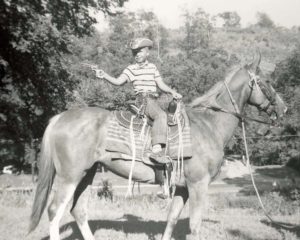 By Steve Crum
By Steve Crum
There is a silent, 8mm home movie of me as a toddler in 1952, wearing a specially made double holster with silver studs and fancy cap guns, patterned after Hopalong Cassidy’s six-shooters. My Grandpa Axtell was a western fan, and paid to have the holster constructed. That holster lasted for several years, until I ran out of belt holes as my body grew up and out. 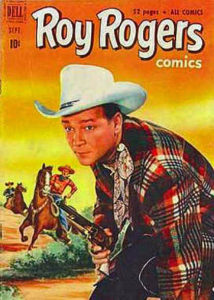
I was still wearing it when the photo here was taken of me on Grandpa’s horse.
From the moment I could barely walk, I was exposed to black and white TV westerns—like virtually every other kid in the country. Cowboy heroes dominated the tube from the late 1940s (the dawn of TV) through the ‘60s. Reruns of William Boyd’s 66 Hoppy movies produced in the 1930s and ‘40s made Boyd and his Hopalong character THE biggest stars of early TV. He was the man who dressed in black, rode a white horse (Topper), and sported a silver-studded, double holster. Boyd then starred in half hour episodes made for the new medium. Gene Autry and Roy Rogers joined Boyd with their own made-for-TV series. Their old movies were also rerun. “The western march had just begun,” as television’s Davy Crockett theme said in 1955. Autry’s production company also gave us new western heroes like Annie Oakley, The Range Rider, and even Champion (Gene’s horse).
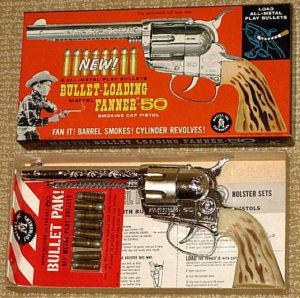 Movie theaters downtown and at drive-ins were western crazy too, with the likes of John Wayne, Randolph Scott, and James Stewart. All my neighborhood’s boys emulated their cowboy heroes as we spent summers playing cowboys vs Indians, and good cowboys vs bad cowboys. Toy cap guns, sold in every dime store, were essential. And nearly every hit TV western hero was merchandized, taking the cue from William Boyd. Carrying a cast iron and plastic toy gun loaded with a roll of caps was the norm. There were The Rifleman’s rifle, Wanted Dead or Alive’s “mare’s leg” sawed-off rifle, The Lone Ranger’s pistol, Wyatt Earp’s long-barreled Buntline Special, and dozens more. At the western genre’s peak in popularity during 1959, there were no less than 30 western series broadcast each week. Twelve years later, the cowboy craze had nearly disappeared into the sunset.
Movie theaters downtown and at drive-ins were western crazy too, with the likes of John Wayne, Randolph Scott, and James Stewart. All my neighborhood’s boys emulated their cowboy heroes as we spent summers playing cowboys vs Indians, and good cowboys vs bad cowboys. Toy cap guns, sold in every dime store, were essential. And nearly every hit TV western hero was merchandized, taking the cue from William Boyd. Carrying a cast iron and plastic toy gun loaded with a roll of caps was the norm. There were The Rifleman’s rifle, Wanted Dead or Alive’s “mare’s leg” sawed-off rifle, The Lone Ranger’s pistol, Wyatt Earp’s long-barreled Buntline Special, and dozens more. At the western genre’s peak in popularity during 1959, there were no less than 30 western series broadcast each week. Twelve years later, the cowboy craze had nearly disappeared into the sunset.
MILITARY FANTASIES
Heroics were not exclusive to cowboys. John Wayne portrayed both a cowboy and a military hero (particularly Army and Marines) in his most popular movies. While I never dressed up like a soldier to play military battles, I did fantasize about the heroism of soldiers during WWII. Among my collected comic books were Sgt. Rock’s Our Army at War. The machine guns and tanks were particularly thrilling.
The back page of most comic books was nearly always an advertisement for magic tricks, selling greeting cards, or buying one’s own set of fighting soldiers. I bit on one of the latter ads, after saving my allowance for over a month to buy a “foot locker” packed with soldiers holding their 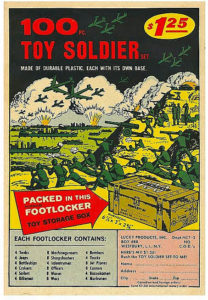 rifles and pistols. When I finally received the package, I discovered the foot locker was about the size of a Cracker Jack box, and the soldiers were tiny, flat-sided, brittle plastic things that kind of resembled soldiers. Standing them upright was a challenge. G. I. Joe dolls were prevalent around this time, as well as Aurora plastic model kits of military tanks, cannons, armed soldiers, etc. Some of my pals had them, but I did not. There were even plastic toy hand grenades that required a “stick ‘em” cap to be inserted, and would sound with a bang upon landing.
rifles and pistols. When I finally received the package, I discovered the foot locker was about the size of a Cracker Jack box, and the soldiers were tiny, flat-sided, brittle plastic things that kind of resembled soldiers. Standing them upright was a challenge. G. I. Joe dolls were prevalent around this time, as well as Aurora plastic model kits of military tanks, cannons, armed soldiers, etc. Some of my pals had them, but I did not. There were even plastic toy hand grenades that required a “stick ‘em” cap to be inserted, and would sound with a bang upon landing.
Adding to my military exposure were a couple of popular newspaper comic strips, Terry and the Pirates and Steve Canyon, both created and inked by Milton Caniff.
THE VIETNAM WAR AND THE MASS MEDIA
Hollywood’s connection to The Vietnam War was unlike its role during WWII, when the studios were dedicated to winning the war via producing anti-Nazi and anti-Japanese films. The propagandizing was effective, and no doubt helped us win the war. Even Bugs Bunny and Popeye cartoons had such propaganda themes.
By the time I was drafted to serve in the Army in 1970, The Vietnam War was somewhat winding down. The only Hollywood film clearly supporting our involvement in the war was The Green Berets (produced two years earlier), named after the hit song, “The Ballad of the Green Berets,” sung by Barry Sadler. However, some took 1970’s Patton as pro-war, even though it was WWII based. In many ways, the film was also anti-war. I supported the latter position—before, during, and after my two year tenure.
A note in passing: I loved Patton, but abhorred and laughed out loud at The Green Berets. I saw them both while an Army Specialist. 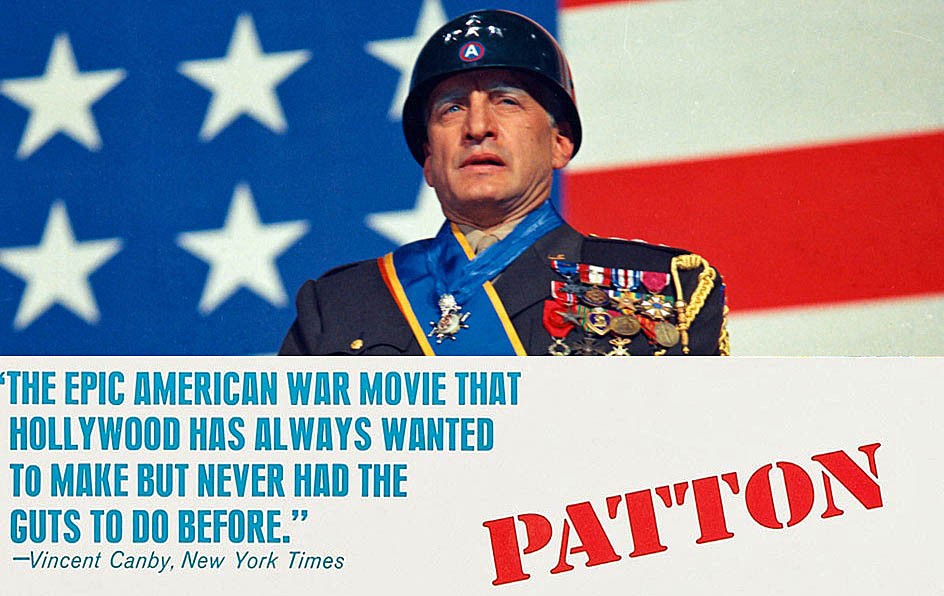
=====
During my Basic Training at Ft. Leonard Wood, I heard many references by drill sergeants to John Wayne: “John Wayne would 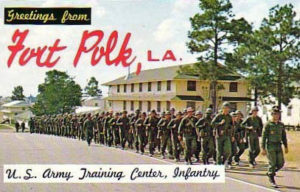 throw a grenade like this,” and “John Wayne would never do that.” During my next duty stop, at Ft. Polk, I discovered John Wayne war movies were shown daily, and free of charge, at the fort’s Tiger Land movie theater. WWII propaganda had segued into the Vietnam era.
throw a grenade like this,” and “John Wayne would never do that.” During my next duty stop, at Ft. Polk, I discovered John Wayne war movies were shown daily, and free of charge, at the fort’s Tiger Land movie theater. WWII propaganda had segued into the Vietnam era.
REAL GUNS/TOY GUNS
Outside of my time in the Army, the only rifle I had ever fired was during the late 1950s when my father loaned me a 4-10 and took me hunting for quail. Both times, I never shot anything. I really had no desire to do so. But being with Dad was special. It happened so rarely.
=====
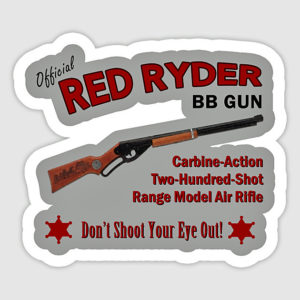 For decades, the only gun I have in the house is a Red Ryder BB Rifle of “you’ll shoot your eye out” fame. It remains unfired and BB-less since a friend gave it to me 20 years ago.
For decades, the only gun I have in the house is a Red Ryder BB Rifle of “you’ll shoot your eye out” fame. It remains unfired and BB-less since a friend gave it to me 20 years ago.
The spent-powder smell of a cap gun still lingers in my sensory memories, but that was then and this is now. The romanticism of being a cowboy remains a happy escape, and I still love the old flicks on DVD.
=====
Did I forget to mention my United States Army medal for M16 rifle qualifying? I am a Sharpshooter. Go figure.
=====
You should find this piece about toy guns interesting:
